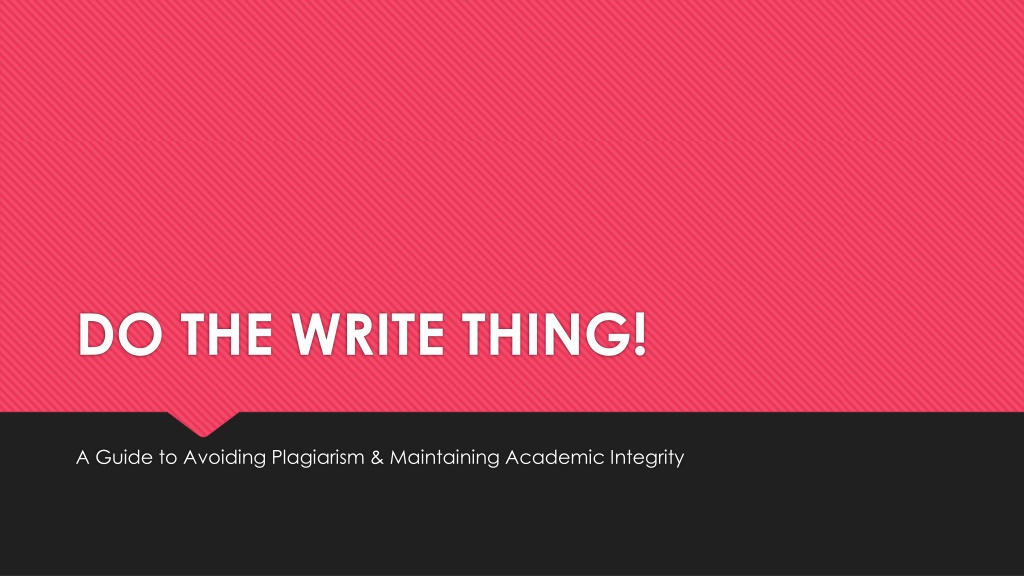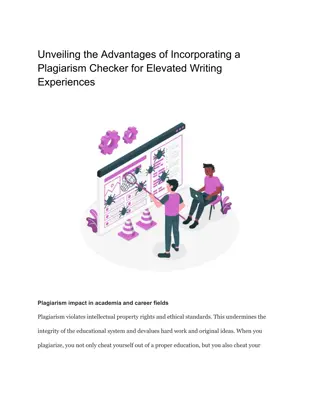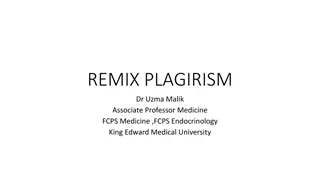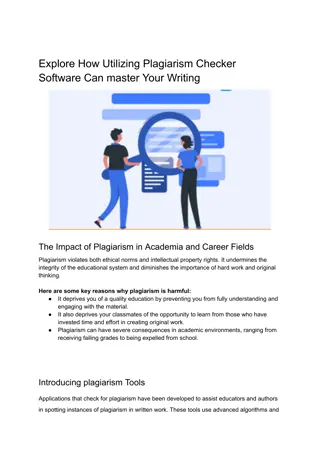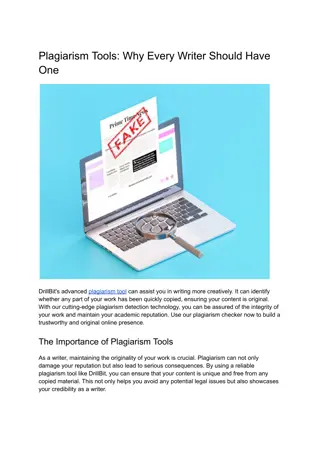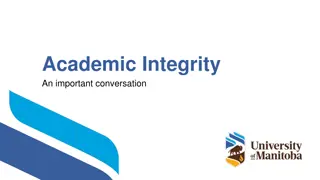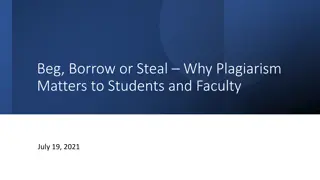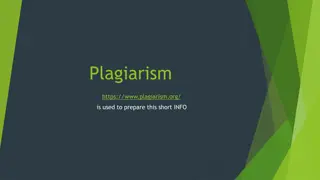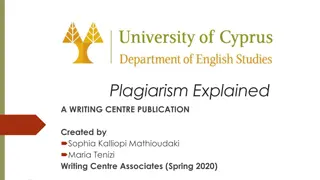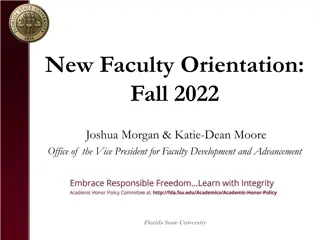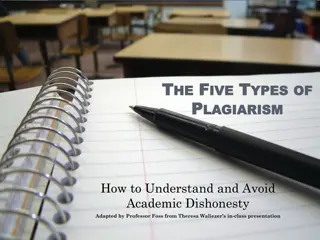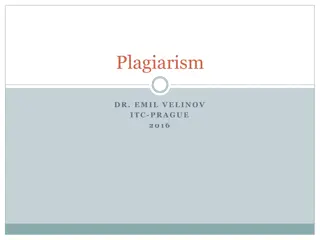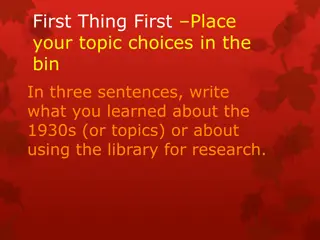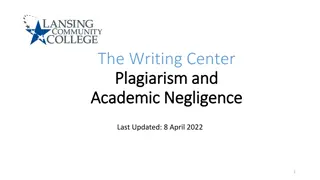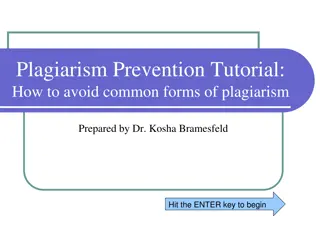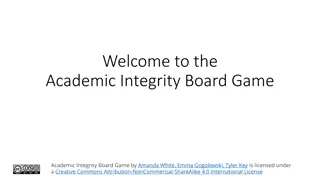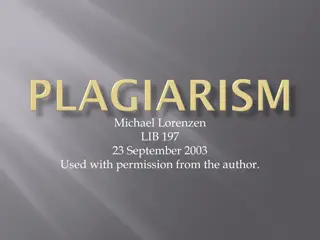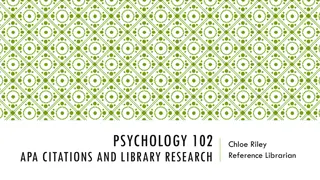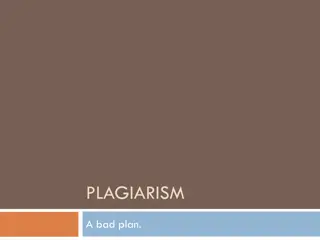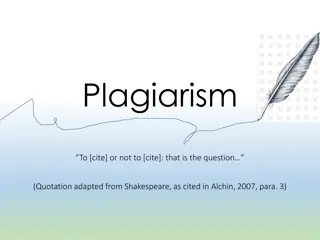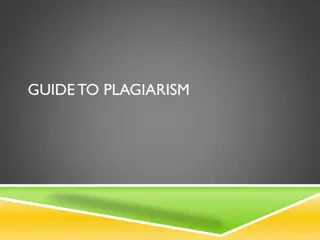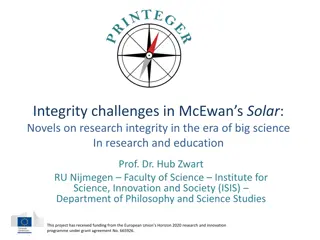Avoiding Plagiarism and Upholding Academic Integrity
Understand what plagiarism is and the consequences associated with it. Learn to identify signs of plagiarism and differentiate between good and bad use of sources. Find out why avoiding plagiarism is crucial for academic success.
Download Presentation

Please find below an Image/Link to download the presentation.
The content on the website is provided AS IS for your information and personal use only. It may not be sold, licensed, or shared on other websites without obtaining consent from the author. Download presentation by click this link. If you encounter any issues during the download, it is possible that the publisher has removed the file from their server.
E N D
Presentation Transcript
DO THE WRITE THING! A Guide to Avoiding Plagiarism & Maintaining Academic Integrity
WHAT IS PLAGIARISM? Random House dictionary- "the unauthorized use or close imitation of the language and thoughts of another and the representation of them as one's own original work. Northwestern University: "Failure to acknowledge the sources from which we borrow ideas, examples, words and the progression of thought."
LINKS TO VIDEOS IN THIS PRESENTATION ARE AVAILABLE ON THE SAME WRITE PLACE WEB PAGE WHERE YOU FOUND THIS (see Tutorials )
Signs of Plagiarism When Information that is not common knowledge is included without mention of source When style and tone of writing changes abruptly
Theres a thin line between good use & bad use of sources GOOD Using quotations BAD quoting material without attribution Using someone else s key terms imitating a passage's structure or argument without attribution Summarizing someone else s main point passing off another's ideas as your own, even if re-worded (the underlying idea of plagiarism is unacknowledged borrowing of ideas, not just words) Concealing the extent to which you've borrowed Putting someone else s words in your own words (paraphrase)
Are you a cheater? o 75% of college students admit to cheating (Huffington Post) 1 out of 3 high school students admitted that they used the internet to plagiarize an assignment (The Josephson Institute Center for Youth Ethics) o 40% of college students admit to cheating on written assignments (Donald McCabe, Rutgers University) o
Why does it matter? When you plagiarize you run the risk of academic consequences When you plagiarize, you signal that you are not a trustworthy student, everything becomes suspect When you plagiarize, you rob yourself of knowledge but isn t gaining knowledge the reason you re here?
But research is too hard It s not hard, it just takes time
3 Steps to Avoid Plagiarism Researching Note-taking Documenting
Researching Estimate the amount of time you think it will take to conduct your research, and then double it! Expect to make trips to the library or at least the library databases Allow time for gathering materials Allow time for reading
Reading Read the chapter (or article) to get a basic understanding In a sentence write what the main point of the chapter is (hint: what s the title?) Read through the 2ndtime more slowly section by section Write a sentence or 2 summary of each section in the margin or in your notebook
Trouble understanding something you read? Email your teacher o Partner up with a classmate or study group o o Call on us! Make an appointment at the Writing Center
Note-taking Sloppy note taking increases the risk that you will unintentionally plagiarize. Unless you have taken notes carefully, it may be hard to tell whether you copied certain passages exactly, paraphrased them, or wrote them yourself. This is especially problematic when using electronic source materials, since they can so easily be copied and pasted into your own documents.
Note-taking Identify words that you copy directly (put quotations around them!) Jot down the page number and author or title Keep a working bibliography Keep a research log
Bibliography? It s another word for Works Cited or Reference list Go to Purdue Owl for guidance on what information is needed for each type of source This will be based on the style of documentation required (APA? MLA? Other?) And the type of source it is (website? Journal article? Book?)
Research Log? A notebook that contains only the notes that you take while doing research For each source you begin with the bibliographic information, then follow with the notes and quotes that come from that source
Research Log Example Gladwell, Malcolm. Outliers: The Story of Success. New York, Back Bay Books, 2008. Here I have put the information about source at the top. It is already formatted as an MLA Works Cited entry. The university is a delightful place; lots of room in the classes and residences, no crowding in the cafeteria, and the professors are solicitous. (135) Gladwell describes a reality that did not exist for Blacks in the 1930s! He completely ignores the fact that this wasn t true for everyone The sense of possibility so necessary for success comes not just from inside us or from our parents. It comes from our time [and]our particular place in history. (137) Here are quotes taken directly from the book. Notice: quotation marks indicate exact, word for word from original. Ellipses indicate a portion was left out and brackets around and indicate my addition. Here are my opinions about what this author has said
Documenting Any time you incorporate into your writing ideas, words, key phrases, or pictures that were not originally created by you, you must give credit to the original author by citing the source.
What do we mean by cite? To cite means to signal to the reader where the words, information or ideas that come from another source begins AND where it ends. In other words, to cite is to introduce and end each use of a source with appropriate documentation (i.e. signal phrase and end text citation or footnote)
Plagiarism comes in all shapes and sizes! Direct Plagiarism Copying word-for- word from an outside source without quotes or citation
Mosaic Plagiarism Interweaving one's own words with that of an outside source in an effort to camouflage "stolen" information and pass it off as completely original work.
Paraphrase Plagiarism Insufficient Acknowledgement o Changing only a few words here and there, but maintaining virtually the same words and ideas in the original source without using quotations (even if source is cited), (2) putting the ideas of another in your own words, without citing source. o Citing a source once although it is used more than once, or improperly citing a source, perhaps quoting with no end note or vice versa.
Do you know how to paraphrase? Link to this video is available on Write Place web page where you found this presentation.
TEST YOUR KNOWLEDGE! IS THIS PLAGIARISM? Link to this video is available on Write Place web page where you found this presentation.
TEST YOUR KNOWLEDGE! IS THIS PLAGIARISM? Copying all or part of a paper from a book? Turning in a paper someone else wrote with your name on it? Buying a paper from a "research assistance" type company? Downloading material from the Internet? YES_____ NO _____ YES_____ NO _____ YES_____ NO _____ YES_____ NO _____
TEST YOUR KNOWLEDGE! IS THIS PLAGIARISM? Using the same paper for one class that you wrote for another one? Incorporating ideas and/or wording that your roommate, parent or writing center consultant gives? YES_____ NO _____ YES_____ NO _____ Allowing a friend or writing center consultant to re- write phrases, sentences or paragraphs for you? YES_____ NO _____
Link to this video is available on Write Place web page where you found this presentation.
